I have 2D data that I want to cluster into K clusters. Lets suppose K=4. After running the clustering algorithm, each point has a 4 length probability vector (whose entries add up to one) indicating the probability that the point belongs to each one of the clusters.
My idea is to assign a color to each cluster and after that make a scatter plot wherein each point is colored as a mixture of all the colors according to its probability vector. If K=3 it the colors could be RGB and therefore I could make use of something like ax.scatter(x1, x2, facecolors=probability_vectors) like its said in this question . I used that solution to make the plot in the image which has K=2 (fixing the Blue column to 0 in all vectors). I could still use it for K=3 but for K=4 I need something different. Any suggestion?

EDIT:
Using Tomáš Šíma answer, if I use this code (for 5 clusters):
import colorsys
from matplotlib import pyplot as plt
import numpy as np
N = 5
HSV = [(float(x)/N, 1, 1) for x in range(1,N+1)]
RGB = map(lambda x: colorsys.hsv_to_rgb(*x), HSV)
print HSV
plt.scatter(range(N),np.repeat(0.5,N),c=RGB,s=200)
I get this output:
[(0.2, 1, 1), (0.4, 1, 1), (0.6, 1, 1), (0.8, 1, 1), (1.0, 1, 1)]

My problem now is that if I had one point whose probability vector is [0.5, 0.0, 0.0, 0.0, 0.5], i.e. one half for the yellow cluster and one half for the red one, its color should be orange. However, if I do 0.5*0.2 + 0.5*1.0 I get 0.6 which is blue. How should I compute the average in order to get orange instead of blue?
EDIT 2:
Got it, I just have to average the RGB version of each cluster centroid (instead of the HUE)
